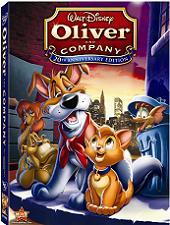Released in 1988, Disney’s 27th full-length animated film is now presented in a special edition DVD celebrating its 20th anniversary. Brilliant animation, a fantastic soundtrack and the amazing voice talents of Billy Joel, Bette Midler, and Huey Lewis, puts Oliver & Company on track to win the hearts of a whole new generation, and the occasion for us to share memories of the production of the movie with no less than its director!
George Scribner was born and raised in the Republic of Panama, where he attended grade schools and drew his way through most of his classes: motorcycles and cartoony looking iguanas! After high school in Florida, he majored in film at Emerson College in Boston and moved to Los Angeles to pursue animation. He became an animator at the Walt Disney Studios in the early 80s and it is in 1988 that he directed Oliver & Company. After working on numerous other features including The Lion King and Dinosaur, he’s currently the animation director for Walt Disney Imagineering.
An amazing journey for a “lucky guy”, as he calls himself!
 Animated Views: Can you tell us about the origins of that twist on Oliver that is Oliver & Company?
Animated Views: Can you tell us about the origins of that twist on Oliver that is Oliver & Company?
George Scribner: The idea was pitched in a group meeting very early on when [Jeffrey] Katzenberg and [Michael] Eisner had just taken over and they were looking for ideas for animated features. I was partnered with a story person named Pete Young and his wife had actually suggested it to him. He threw it out at this group meeting with Jeffrey, Michael and animators and story people and they adopted it. They liked this idea of using animals set in New York based on the Oliver Twist story. I think Jeffrey had always wanted to do that story. So, this was an idea that was from a partner who I then joined and then helped develop. But it was Pete Young’s idea.
AV: You were the sole director on that production, which is unusual at Disney. How did that come about?
GS: I think that when the new management came in, they were determined to try new techniques. Their backgrounds were live-action films that obviously had one director. They were determined to not do films as we had done them in the past. They thought that we had taken too much time and that we were gonna try something different. And this was part of it. We would go to sole director, one vision leading a film from start to finish. When I began the project, I was pegged with another director and that director moved out. His name is Rick Rich; he directed Black Cauldron. So, I became the sole director about six months after I was put on it.
It was a lot of work being the sole director. And because it was my first movie, I didn’t always have the answers and didn’t always quite know what questions to ask. So, I was learning as I was going on as well. I wish I had known then what I know now, but I didn’t and had to learn sort of on the job. That’s the approach they took. We were gonna make a movie and if we made mistakes, they would be our mistakes, so we would make our own film. This was gonna be a new approach.
AV: The story was created both storyboard-wise and script-wise. How did you make those two different approaches work together?
GS: In animation, we used to storyboard everything and put everything up on reels as animatics using small sketches. We would always start with a series of images that then generate a structure or we could start with a written structure and build from that. I personally feel that there is a huge role to be played by good writers working in tandem with story people, and that’s how we started on this. We spent quite a bit of time actually working out the structure on paper written, because, frankly, in my opinion, it’s a lot simpler to work out the story structure in pages than it is to try and board everything.

It’s a lot of work drawing out what could be simply done in beats. You map out pretty quickly and more efficiently on paper and that’s how we did it on that one. But they sort fed one another. Story ideas would come out of sketches. Vance Gerry, one of the story people there, did a sketch of Oliver riding on the base of a subway, and it became an entire sequence. It was so inspiring. Some story people are so gifted that they’re stealing in a sketch really an entire story beat. So, they really went back and forth.
AV: As you mentioned, the new Disney management came from a live-action movie background and were more used to screenplays than storyboards.
GS: You’re absolutely right. That was their background and they were used to it. We kept pushing back saying: “we got it and we appreciate the need for it. But don’t discount what really strong story people can do in a series of sketches. They have gifts that really can complement the work of a writer”. You know, they were learning as well and Jeffrey certainly picked up very quickly the benefit of both and he let us do what we wanted to do.
AV: After a few years of non-musical features at Disney, Oliver & Company was the first film of its decade to really feature strong songs that involved the characters and progressed the story.
GS: Like on most of the films of that kind, we tried a lot of different things that didn’t work. But we knew right away that we would set music to it and we kept arguing for: “let’s just make sure that the music advances the story so that we don’t have, like in a lot of musicals, story stopping to allow a musical number to take place, so that the songs themselves really put forward either someone’s motivations or major story points.” And everyone agreed. And Jeffrey, to his credit, understood that as well.

Because it was set in New York, in such a rich choice of music – including salsa – it was kind of a perfect setting for sort of a mix and you could almost drop anything and do it, including Bette’s showpiece, Perfect Isn’t Easy. It just adds so much more length to a film and it just heightens the way of telling stories. So, we knew early on we were gonna use music in this and getting Billy Joel on board really helped set the tone for the rest of it.
AV: Again, a different approach was that the songwriters on this film were numerous, unusual for a Disney film. How did that happen?
GS: I think it’s part of the process of the film we were learning as we were working on it. Because it wasn’t a flat-out musical, compared to the work that Howard Ashman brought to Little Mermaid and Aladdin, and because it was more of an eclectic series of environments, and we were in New York. Also, we didn’t have a single composer because we didn’t really have one at the beginning and we sort of were making it up as we ran along. Billy gave us the tone, but it wasn’t right for some of the other characters, and it felt like the variety that we could bring to it would just add sort of a texture to it that would be just as strong. Rubén Blades’ piece Buscando Guayaba so identifies with Tito that I can’t imagine writing it any other way. I’m not sure someone with a musical or Broadway background could have written something that would have sounded that true. So, it was a little of both: we were sort of making as it was running along and it sort of felt right for the film.

AV: From Billy Joel to Bette Midler, the film gathers an impressive array of stars, both singers and vocal acting talents.
GS: Jeffrey felt that having people like Billy, Bette Midler, Ruth Pointer, etc, would only add another layer of appeal and interest to the film. He has a very strong commercial instinct, I have to admit, not having done anything like this. My take on it always was that it really doesn’t make any difference. If the voice talent is appropriate, if the song is appropriate, then there can be a star. I mean, that’s secondary. But I have to admit that his instinct was probably right. He would always argue: they’re great for a reason, they’re great because they’re fantastic, because these artists are really accomplished. They won Grammies and they have enormous appeal. And they’re good and they’re only gonna add strength to your film. And I got it, I understood that.
Actually, they were very easy to work with. Most of them had small children. So, they knew that they’d be part of a project that was gonna last forever, that their children would grow up and know that their father had done a voice in a Disney animated film. So, they were very professional, very easy to work with – Billy Joel particularly. We had a lot of fun in dialogue sessions in New York. He was like a little kid! He loved the idea that he was doing a dog. It was the strangest idea in his head. “Look, this is your world. You just are gonna be 20 inches off the ground now. What does the world look like through your eyes? Put yourself in the position of this animal who can think and breathe and talk.” They brought a lot to it and loved the idea of being part of something larger than themselves, because animated movies have a much longer life than a lot of live-action pictures.
AV: Speaking of voices, the character of the major villain Sykes was originally intended to be just a voice, wasn’t he?
GS: That’s a decision that just evolved over the course of the animatics, the story reels. I was the one who pushed for not seeing him, that he was more powerful and more threatening if you never quite ever really saw him. Viewers’ imagination is probably more powerful than literally depicting somebody. The animator of Sykes, Glen Keane, felt very differently. He felt very strongly that the only way to show his strength and his power was to actually reveal him. And, I have to say, he was probably right. You have to be a little more literal in an animated film. You maybe could get away with it in a live-action picture that is a little more subtle. These pictures tend to be not exaggerations, but broader colors. You have to be a little clearer and a little broader.
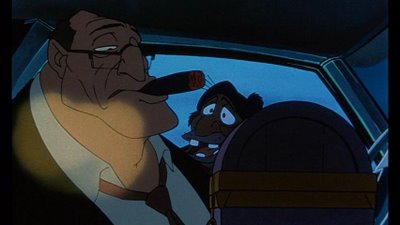
AV: In what way did your research trip to New York help shape out the movie?
GS: Quite a bit, actually. Our biggest goal, when we went to New York, was to try and capture as much of the texture of it as possible, but from 12 inches height. So, the camera was always shooting at very, very low angles. It was an entirely different perspective. You really have to force yourself to get into it. We took countless photographs and saw so many different environments and colors. There were the smells and all that the different locations could bring to you. I think it really brought a lot to the film. Because it’s an animated movie, obviously a lot of it got lost. But I think we managed to hold to a good part of it through most of the sequences.
AV: Considering the great tradition of Disney animated animals, was it difficult to find a new way of treating dogs?
GS: Yes, it was. We tried, particularly Tim Disney and myself, to push this. Tito was originally a character called Scrapper and I felt, during the story process: let’s make it more local. This is a Porto Rican animal living in New York. Because I was from Panama and I understood that culture, I really pushed it. It’s an example of just trying something a little bit different, a little more urban. And he’s a perfect example of it. And so is the poodle, Georgette: very theatrical, very Broadway, very heightened, very pushed. We succeeded some times; we didn’t do as well some other times. In Einstein, I would have loved if it had got more color. But it is what it is.
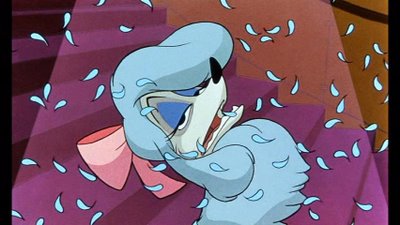
AV: The film seems to have picked up on the New York streets aspect: the sometimes rougher backgrounds of Oliver, with their black outlines, reminded me of the backgrounds to One Hundred And One Dalmatians.
GS: We knew we wanted to go with that Xerox lines look over washes and simple gouache paintings because it would add a grip, it just gave us more of an edge to it. We were trying to get a little more variety, a little harder edged to the tone of it, so to replicate New York. It was gonna be a soft or delicate, pastel approach to the city, with a lot of colds and warms. It was going to be a little more urban, not a lot of colors, more in terms of value. And there was a deliberate decision to go that strong Xerox line for that reason.

AV: Again recalling Disney’s animated dog films, in Oliver there are some sweet references to former Disney animal movies with cameos from Lady and the Tramp and One Hundred And One Dalmatians.
GS: They were more like inside jokes. It’s more like throwaway gags. I think it came out one of the story sessions like “wouldn’t it be fun to see all the other dogs from the other movies?” It’s a little homage, I suppose. For the millions of Disney fans who love these movies, they would get it and it would just add another very small layer of enjoyment, I suppose!
AV: What was the input of the Disney legends of animation like Vance Gerry or Frank & Ollie on Oliver & Company?
GS: To be honest, they didn’t bring that much. They came very early on, when the story was very rough and needed a lot of work. There was Frank & Ollie. I believe Ward [Kimball] came, too. I don’t think they were very impressed! But at the time, it was very rough. We were having story problems and we needed to bring them in. Ward, in particular, had very strong story suggestions and had a lot of very good ideas which we ended up using.
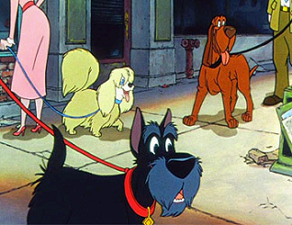
AV: At the same time, your team of animators was the “crème” of the new generation.
GS: Because it was my first film, I didn’t have anything to compare it to, but I did know that they were good for a reason. Because scenes would come in from these animators like Mike or Glen or Andreas Deja, and I could see how good they are. I had directed theater prior to directing animation and, when you get performers that you direct and you work with, you give them a direction and emotional context and they deliver something that you didn’t expect, that’s the mark of really strong, true and gifted performers, and these actors on paper are no exception. They’re great for a reason because they constantly surprise you. You gave them the intent of a scene and they delivered way more than you expected. There was a joy. It was just a revelation to get scenes back and go “I never would have thought of that; that’s unbelievable!” They all were so gifted! Mike Gabriel in particular could do things like that.
AV: Do you think of one scene in particular?
GS: He did one scene of Fagan in the boat, about to read to the dogs at night. It’s a fairly long scene. It was about 40 or 50 feet in length. It’s one of the most remarkable pieces of human animation. It’s so beautifully drawn and acted. I remember as Fagan sits, then the dogs bring a blanket and they put it on him and they give him the book and they’re all pressed up, ready for him to read that bedtime story.
AV: It’s also one of composer JAC Redford’s most beautiful cues in this film.
GS: Yes! He did so gorgeous work on that film!
AV: Oliver & Company also features an extended use of CGI for the time.
GS: We always knew we were gonna use this because there was so much geography and draftsmanship and dimensional settings given that it was a city, and given the look of it, which is more hard-edged, more real environment. We just knew that it was supposed to be part of the palette of tools that we would turn to. Technology had reached the point where they were able to generate entire locations – the entire subway sequence, for example, was done digitally. It just gave a level of believability that, if we had hand-drawn it, it would have had a lot of jitter to it and it would not have been as accurate. It gave you a perspective and an accuracy that doing it by hand wouldn’t have done.

AV: What are your memories of working at the Glendale facility of Walt Disney Feature Animation and not at the original studio?
GS: It was a tough period for animators. They’d been accustomed to working on the lot and had been moved out. The management wanted to make the animation building suites for production deals for live-action, and they weren’t happy about it. As for myself, I was so happy to be there. I had worked at other studios before and things were very different. Working at Glendale was a luxury. Where would they put us, we would make the best of it. I know they’d wish to be able to stay in Burbank and it would have been nice, it was a beautiful environment to work, the rooms were nice, the way was set up and you felt that you were “on the lot”, part of the studio. But the irony is that some of our greatest films came out to be in Glendale, in these warehouses. A friend of mine called them “the witness protection warehouses”. You don’t even know where you are!
AV: Now that we’re celebrating Oliver & Company‘s 20th Anniversary, how do you feel about that film?
GS: I’m really proud of it. It’s something that took me five years of my life. We went through a lot of stress to get it done. Pete Young, who originated the idea passed away about nine months after the beginning of the production. It was tough. And because we were learning as we ran along, it made it a really interesting experience. It was highs and lows just like anything else. Looking back at it, I’m like: “Oh man, I would love to redo this. What was I thinking?” But I think that’s just life. I would have done a lot of things differently but overall, it has an energy and a sense of fun to it. We just wanted to make something that we would enjoy, and it just turned out actually kind of fun.
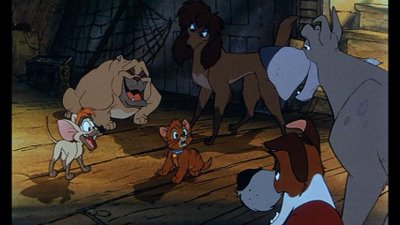
AV: It’s also a very sweet movie, in many regards.
GS: That’s true. There’s a lot of gentleness to it, underneath. You know, my favorite movies are the simplest structured films like Dumbo and Jungle Book. These are very simple, sweet stories with great characters hung on a very simple arch. I think Nemo is that way. It’s a very simple story. Maybe Oliver is a little bit too complicated. I wish it had been simpler, to spend more time with the characters themselves.
 AV: After Oliver, your directorial experience continued with The Prince and the Pauper. Can you tell me about that very special Mickey Mouse featurette?
AV: After Oliver, your directorial experience continued with The Prince and the Pauper. Can you tell me about that very special Mickey Mouse featurette?
GS: You know, of all the things I’ve done, I’m probably the most proudest of that. We took characters that you didn’t ordinarily think could be placed in that kind of drama. To place a character like Mickey Mouse, a fairly one dimensional figure, at the bedside of the death of the king, I thought we’d pull it up because we tried to do it with a lot of restrains. It was really a joy to work on and I’ve learned probably more from doing that film than I did for Oliver. In a lot of ways it was simpler, with simple characters that didn’t have to be designed – they were all there – but it had its own challenges: can we pull up with these characters and a fairly traditional story? It is what drew me to it when I first read the script: can we pull this off? Can we place a flat cartoon character in that situation where the father of the real prince passes away without being laughable, that Mickey Mouse is pretending to act? And I think it worked!
AV: Then you went on to Lion King for a while?
GS: I spent two years on Lion King. Jeffrey and I had a different of opinion on it. I left and then started doing projects for Walt Disney Imagineering, where I am now, because I had met all these people during that period of time. It was a great experience, though. It’s just that Jeffrey had a different way he wanted to go. That’s the way life is.
AV: You were also at the origins of Fantasia 2000. Can you tell me about the sequence you initiated?
GS: I worked as a director on an early version of the Pomp and Circumstance sequence where Donald was gonna deliver jewel to the children of the Princes & Princesses of our films. It was an idea that was proposed about a year before we tried something else. It just wasn’t working.
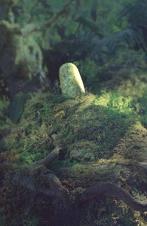 AV: Another animated feature you started was Dinosaur. What happened there?
AV: Another animated feature you started was Dinosaur. What happened there?
GS: I was the original director on it. Then Ralph Zondag came on. My inspiration was the work that Phil Tippett had done. He had done some stop motion work with dinosaurs that really had a lot of personality to them. Because they were all stop motioned, they had a certain look, a certain signature, even though they were not photorealistic. They felt slightly caricatured. He really had done some beautiful work. We started from that sort of look and it evolved from there. Like most of our stories, the story of Dinosaur went through different iterations. I spent two years on it and left to join Imagineering. But fundamentally, the story was pretty much the same after I left.
AV: How did wind up moving to WDI?
GS: Peter Schneider asked me to do some small projects for Imagineering and I met them all. So, when I left Dinosaur, I wanted to try something else. I’ve always enjoyed working with Imagineering. They were doing a lot of projects for the second gate in Paris and some other parks. The theme parks needed a lot of animation, so, I came over as an animation director, to storyboard, direct, whatever needed to be done for animation. I became sort of the animation guru, so to speak, for Walt Disney Imagineering, which is pretty much what I do now!
AV: Your movie, Drawn to Animation, featuring Mushu for The Art of Disney Animation (in both the Walt Disney Studios Park in Paris and Disney’s California Adventure in Anaheim) has become a classic. What was the challenge of that?
GS: That was really a lot of fun! It was tricky because we had to previsualize where the eyelines would be of most of the live hosts. We had to preplan where his eyelines would be and how much timing it would take a live actor to deliver his lines so that the dialogue with Mushu sounds natural. The fun of working at Imagineering is that all the projects are very different, and this one was!
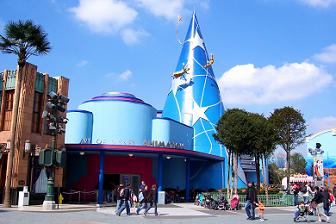
AV: How was it decided that Mushu would be the main character of the show?
GS: The premise of this was that it is part of his personality that he’s so full of himself. He can’t imagine that someone had designed him. Of all the Disney characters, he’s be the most reluctant to accept that idea. So, the point of the show is: a lot of artists spent a lot time coming up with you. And he’s in constant denial of it. I think it was a story person who came up with that idea. We pictured out different characters who might be perfect for that. And it was Mushu that we ended with.
AV: Certainly your most successful film for WDI is the Philharmagic attraction at Walt Disney World.
GS: Yes. I’m really proud of that. That came out fantastic. When I go to Florida for other works, I always go see it. It gets a tremendous response. That was, from start to finish, an amazingly fun little film to make. We spent about two and a half year on that project. Funny, you think these things are short therefore they don’t take much time, but it takes a lot of time to make it!
AV: How was it to turn hand-drawn classic Disney characters into CG characters?
GS: It was a great challenge. The toughest one was Ariel. There is a close-up of her where she comes out in 3D holding the jewels and singing “I want more”. That took us a lot of time to model. And in fact, it was re-done after we’ve finished, and Glen Keane took it over, and improved it a lot. We re-animated the entire sequence with him.

AV: A nice way of associating Walt Disney Imagineering and Walt Disney Animation Studios!
GS: That’s a good way to put it. It was probably the most extensive bi-lateral coordination of two divisions, Imagineering and Animation. Because I came from Feature Animation, I knew most of these animators, I had worked with them. So, there was a complementarity in working with them and working on the models, coming up with the figures. It was a terrific collaboration. We had the very best of Imagineering for the theater set and the design of the theater, and the very best of Feature Animation for the modeling and the animation. It was a very successful collaboration.
AV: The film is based on an intricate relationship between story and music. Can you tell me about that aspect?
GS: We knew there were certain iconic pieces of the music that we just had to have. The premise was going to be Donald trying to conduct the orchestra by using the Sorcerer’s hat, stealing the orchestra from Mickey. He gets swept up into the world of the films because he doesn’t have the possibility to control the power of this hat. And we are now taken through really our strongest musical numbers and they sort of structure themselves. They fell at the right place pretty easily. We knew we would start with Be Our Guest because it’s like “Be our guest! Welcome to this world, Donald! You’re now immersed in a kind of a nightmare. But.. here we go!” And we knew we wanted to end with Aladdin because it was really the most visceral, the most active, and the most climactic. And the pieces that dropped in the middle of it, we sort of shuffle a few of them around occasionally but the structure of it came pretty quickly. And it was always intended to be modular, that we could replace sequences as time went on.
AV: What influences does choosing to create a film in 3D have on its setting?
GS: It has none when it comes to directing a character. You’re still: how good can you get this character to perform? What’s his motivation? What’s his performance? What are the story beats? Here, 3D is absolutely secondary. But in matters of, for example, flying objects, there’s a lot of techniques you can use. But we decided not to try and make the film too aggressive, too scary for small children. It was gonna be gentler, with a lot of what we call more “reach” moments, when you’re reaching out things up on screen, the jewels, the water effects, rather than scary effects. It was a deliberate attempt to make it more family friendly.
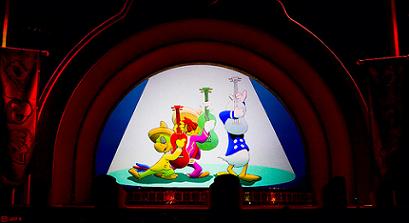
AV: Can you tell me about your latest productions?
GS: About a year ago, we re-did a series of films for the Mexican Pavilion in Epcot, with The Three Caballeros that take us through the country of Mexico. Because I spoke Spanish, I directed in Mexico City the live actors interacting with the animated characters. That was really a lot of fun!
AV: How great it might be to have, as Walt Disney had, one foot in animation and one foot in Imagineering!
GS: I’ve been very lucky! I’ve been able to do both. Because I had a theater background prior to getting in animation, I suppose it made the transition to Imagineering, where you’re dealing more dimensional sets, live sets and more physical environments. I’m very comfortable with that, I didn’t feel intimidated by it. So, I’ve been very lucky it’s worked that well. I’m a lucky guy, Jeremie!
With all our appreciation to George Scribner.


